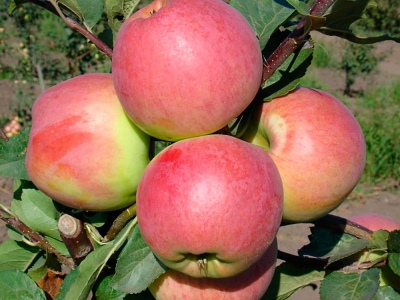
- Authors: All-Russian Scientific Research Institute of Genetics and Breeding of Fruit Plants. I. V. Michurin. N.I.Savelyev
- Taste: sour sweet
- Fruit weight, g: 180-200
- Fruit size: large
- Yield: high, 200-250 c / ha
- Frequency of fruiting: annual
- The beginning of fruiting varieties: for 5 years
- Ripening terms: autumn
- Keeping quality: 2-3 months
- Appointment: fresh
The Uspenskoe apple tree has become widespread among gardeners and summer residents. The plant has gained attention due to its high, high-quality, uninterrupted fruiting and resistance to many diseases.
Breeding history of the variety
Uspenskoe was bred at the All-Russian Scientific Research Institute of Genetics and Breeding of Fruit Plants. I. V. Michurin. The author is N.I.Savelyev. The variety appeared when the Prima and Bessemyanka Michurinskaya varieties were crossed.
Description of the variety
The growth strength of the tree is medium. The crown of the apple tree is spreading, medium-thickened, slightly drooping. Plant height reaches 3.5 meters. The leaves are long, with a twisted, helical tip of a green hue, the surface is very smooth and shiny, with slight nerves and a coarse edge. The branches of the tree are skeletal, covered with gray bark, grow from the trunk almost at right angles, the arrangement is compact. Shoots of medium height, straight, rounded, brownish brown, with medium pubescence. The flowers are large, chalky, have a loose fit of the petals, a shade of light pink.
Features, pros and cons
The pluses of the Uspenskoe variety include:
regular fruiting;
good transportability and excellent presentation;
high scab resistance;
good resistance to winter temperatures.
The plant has only two drawbacks: the tendency to shedding fruits when ripe and a short shelf life.
Ripening and fruiting
The apple tree belongs to the autumn varieties. Fruits begin to ripen in mid-September. The variety has an average early maturity and annual fruiting. The tree begins to produce crops in the fifth year after planting.
Growing regions
The Uspenskoe apple tree is successfully grown in the regions of the Southern and Middle Urals and in Central Russia.
Yield
The Uspenskoe variety belongs to crops with a high yield. 200-250 centners per hectare are harvested from plantations. One garden apple tree can yield up to 40 kg of harvest. Fruits can crumble with late picking, so the harvest must be removed on time.
Fruits and their taste
The fruits have a regular, round-oval, even shape. The apples are large in size, the weight of the fruit is 180-200 g. The color is green, with a light yellow tinge, the integumentary is red, with a blush on most of the fruit. The skin is smooth, shiny, dry. The tasting score is 4.2-4.6 points. Useful substances in one apple: 26.4 mg / 100 g of ascorbic acid, 16.1% of soluble solids, 11.5% of sugars, 396 mg / 100 g of P-active substances. The consistency of the pulp is delicate, fine-grained, juicy, white. The taste of apples is sweet, with a slight sourness. The fruits have a high presentation, fresh apples are used.

Growing features
In order for a tree to grow and bear fruit well, it needs an open, lighted place of growth, protected from winds and drafts. If shading is present, then it should be short-lived. The tree grows well in fertile soil with good air permeability. It can be loamy or sandy loam soils.
The apple tree seedling has a very powerful root system, so before planting it is placed in water for 1 or 2 days. The best time to plant an apple tree is early spring. The soil for planting plants is prepared in the fall.
The planting hole should be 70 cm wide and 90 cm deep. A distance of 3.5-4 meters is maintained between seedlings. Before lowering the seedling into the hole, organic fertilizers are applied to its bottom. Lowering the seedling, its roots are evenly straightened, and when covered with soil, the seedling is slightly shaken so that voids do not form in the root system. The root collar is left above the ground, after which it is well tamped. At the end of planting, 2-3 buckets of warm water are poured onto the root system and mulched with peat.
In the spring, prophylactic pest control is carried out. It consists in whitewashing the trunk with lime. Fallen fruits are collected throughout the season to prevent pests. The spreading crown of the apple tree requires regular pruning. It is held in the spring.



Pollination
The apple tree is partially self-fertile. However, it requires pollinators for a high and high-quality yield. They can be summer or autumn varieties of apple trees.
Top dressing
Throughout the season, the plant is fed with organic matter and mineral fertilizers:
compost;
humus;
manure;
ammonium nitrate;
potash and nitrogen fertilizers.

Frost resistance
The variety has high frost resistance and winters well without shelter. Withstands temperatures up to -40 degrees Celsius.

Diseases and pests
The apple tree has a fairly strong immunity to many diseases. But most often the tree is affected by: fruit rot, powdery mildew, black crayfish. Insect pests can also infect a plant: apple moth, aphid, flower beetle, red tick, leafworm.

The apple tree is a popular fruit crop among gardeners. It can be found in many summer cottages. But at the same time, such trees are often affected by various diseases. It is very important to recognize the disease in time and carry out the necessary procedures for a speedy recovery. Otherwise, the fruits will be spoiled, and the tree itself may die altogether.












































































